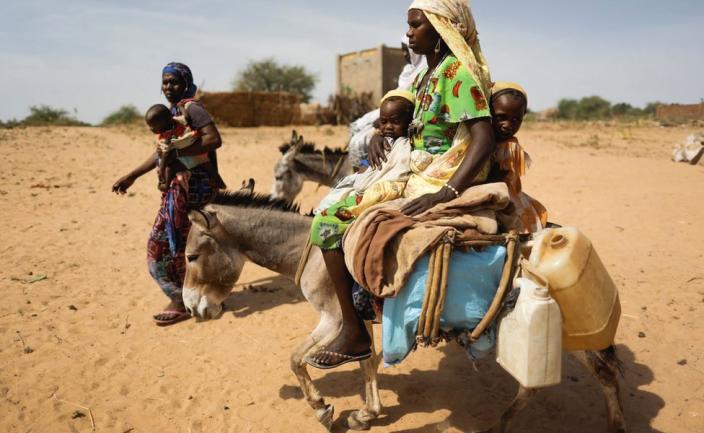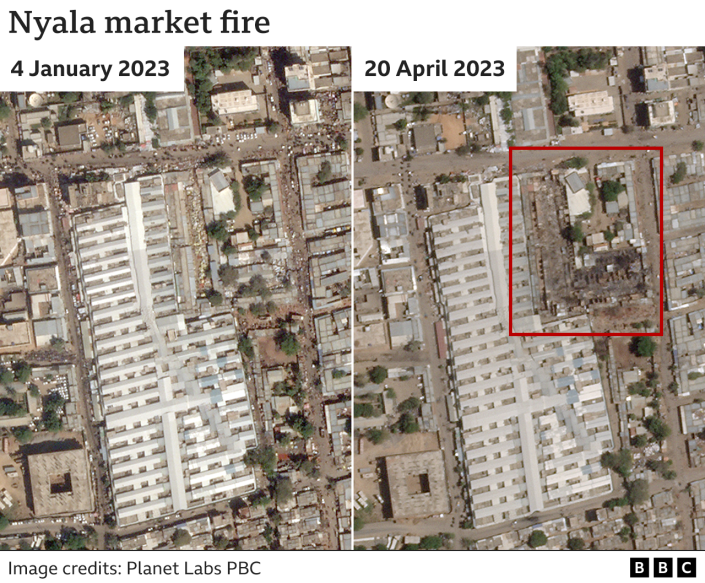
Entire villages in Sudan’s West Darfur region have been burned down by marauding militias, with aid agencies now warning the region is on the brink of a “humanitarian disaster”.
Widespread looting and destruction of vital infrastructure has left many people with little or no access to food, clean water and medicine.
A ceasefire between the army and the paramilitary Rapid Support Forces (RSF) has led to a lull in violence around the Sudanese capital, Khartoum.
But fighting has continued in Darfur, and as the conflict enters its seventh week, the region appears to have descended into chaos.
Those unable to flee the war dug ditches around their neighborhoods and erected barricades to keep out the militia fighters who destroyed everything in their path.
This is the picture drawn by a local journalist from the town of Nyala, the regional capital.
Satellite images obtained by the BBC confirm that a village near Nyala in South Darfur, Abu Adam, has been completely annihilated by fire – the blackened outline visible from space.

Nyala itself suffers from sporadic power cuts and it is difficult to speak with the townspeople. Communications have mostly been cut off. But a local journalist, Essa Daffallah, managed to send me a message.
“The RSF stormed the city with dozens of vans equipped with guns and a large number of motorcycles,” he said, adding that on Friday May 19 “NGO offices and stores were looted.” .
“The hospital was emptied as it was in the combat zone, most of the pharmacies were looted. All the residential areas of Nyala were completely cordoned off with barricades and dug ditches so that the militias cannot not enter residential areas.”
This region was already struggling to help hundreds of thousands of people displaced by other conflicts.
A local activist in Nyala said more than 600,000 internally displaced people, who were entirely dependent on humanitarian aid, have not received any aid for 40 days due to ongoing fighting.

Once again, satellite images tell the story of attacks on key lifelines for civilians, such as the main market – showing that part of it has been destroyed by fire.
This is a huge loss as Nyala supplies the region and even some neighboring countries.
People are in desperate need of help and aid workers are frantically trying to gain access to the area. They have gathered in neighboring Chad with the intention of crossing the border into Darfur as soon as they can.

“We know this is a very high level of risk,” says Justine Muzik Piquemal, of the French NGO Solidarités International. “But we have to send humanitarian goods as soon as possible. Because what we are going to find, I think, will be dead bodies everywhere, and no water. No latrines. And no food.”
Ms Piquemal has organized 13 tonnes of aid, which she hopes will consist of driving a water tank to the town of El Geneina, the capital of Sudan’s West Darfur region.
She tells me that the lack of fuel there has shut down virtually every water pump in an area where temperatures can reach 50°C (122°F).
Communications with El Geneina have also been very patchy since the evacuation of international aid workers in mid-April.
But satellite images show how far the destruction of the city has progressed: the burned areas are visible from space. They cover all the places where civilian infrastructure once stood, according to Ms. Piquemal.

“It’s not [just] military places [to be targeted] like we saw in Khartoum at the beginning,” she says. “It’s more about health facilities, schools, mosques, NGO facilities, anything that civilians can use has been burned down or destroyed.
Even food aid was not spared by the looters. Earlier this month, UN Secretary General António Guterres said some 17,000 metric tons of food had been taken away in the first weeks of the fighting.
The town of Zalingei, in central Darfur, has now become a new epicenter of the fighting. In recent days, it has darkened with a cut in telecommunications, besieged by armed militias.
We managed to obtain an SMS from a resident describing a “catastrophic” situation of widespread looting and displacement.
“The most dangerous thing now is that all food supplies have run out,” he said.
Many residents say the fighters looting and burning these towns are linked to the RSF, which has its roots in Darfur.
The leader of the paramilitary group, General Hamdan “Hemedti” Dagalo, called for calm, although he did not specifically address his troops.
“Reject regionalism and tribalism and stop fighting among yourselves now,” he said in a recorded message to residents of El Geneina. “Stop fighting each other immediately.”
But in El Geneina, the lines of conflict are blurred: alongside the two belligerents there are various community militias, including civilians who have armed themselves to defend themselves and Arab fighters called the Janjaweed – the base from which the RSF were trained.

Twenty years ago, during the Darfur war, the Janjaweed were mobilized by former President Omar al-Bashir to crush a rebellion of non-Arab ethnic groups. Hundreds of thousands of people have been killed. The Janjaweed have been accused of committing war crimes and crimes against humanity.
The current battles have reignited these communal tensions.
“The problem is that it’s not just the two parties,” says Konstantinos Psykakos, project coordinator for the organization Médecins Sans Frontières (MSF), whose El Geneina hospital was attacked. and looted.
Mr. Psykakos is also waiting at the Chadian border for an opportunity to return, but he is painfully aware of the temporary nature of such access.
“The problem is that you start having inter-communal fighting on the ground and you can’t check when the military party starts and when the communal fighting starts,” he says.
“The community fight will not care about the humanitarian corridors. That’s why everyone is saying it has to stop now, because we are at the top of the cliff before we start to decline in terms of fighting and conflict. “

